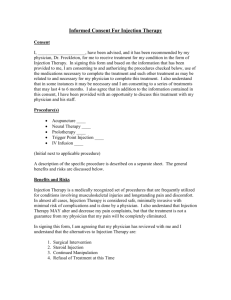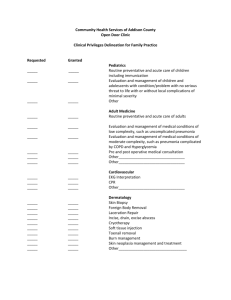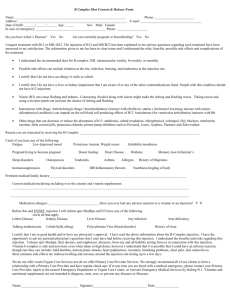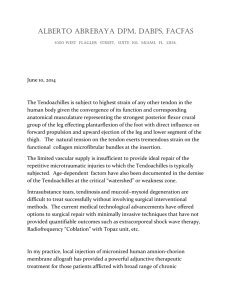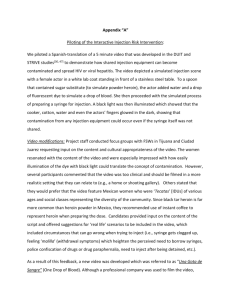CAANS review of Harm Reduction Best Practices, 2013
advertisement
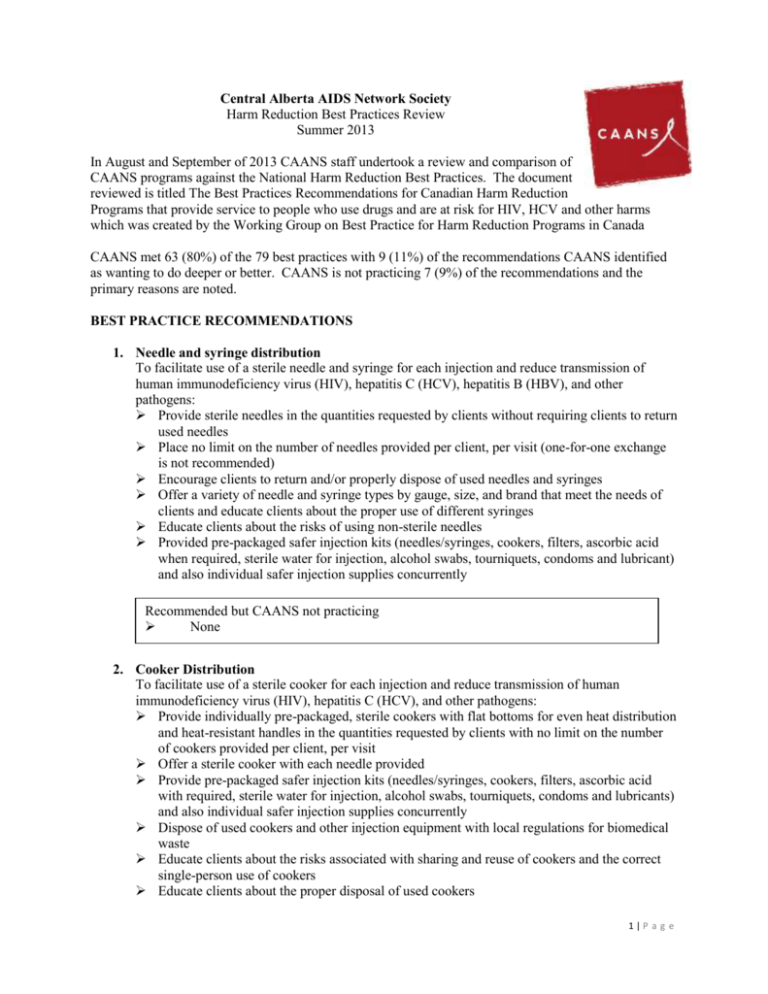
Central Alberta AIDS Network Society Harm Reduction Best Practices Review Summer 2013 In August and September of 2013 CAANS staff undertook a review and comparison of CAANS programs against the National Harm Reduction Best Practices. The document reviewed is titled The Best Practices Recommendations for Canadian Harm Reduction Programs that provide service to people who use drugs and are at risk for HIV, HCV and other harms which was created by the Working Group on Best Practice for Harm Reduction Programs in Canada CAANS met 63 (80%) of the 79 best practices with 9 (11%) of the recommendations CAANS identified as wanting to do deeper or better. CAANS is not practicing 7 (9%) of the recommendations and the primary reasons are noted. BEST PRACTICE RECOMMENDATIONS 1. Needle and syringe distribution To facilitate use of a sterile needle and syringe for each injection and reduce transmission of human immunodeficiency virus (HIV), hepatitis C (HCV), hepatitis B (HBV), and other pathogens: Provide sterile needles in the quantities requested by clients without requiring clients to return used needles Place no limit on the number of needles provided per client, per visit (one-for-one exchange is not recommended) Encourage clients to return and/or properly dispose of used needles and syringes Offer a variety of needle and syringe types by gauge, size, and brand that meet the needs of clients and educate clients about the proper use of different syringes Educate clients about the risks of using non-sterile needles Provided pre-packaged safer injection kits (needles/syringes, cookers, filters, ascorbic acid when required, sterile water for injection, alcohol swabs, tourniquets, condoms and lubricant) and also individual safer injection supplies concurrently Recommended but CAANS not practicing None 2. Cooker Distribution To facilitate use of a sterile cooker for each injection and reduce transmission of human immunodeficiency virus (HIV), hepatitis C (HCV), and other pathogens: Provide individually pre-packaged, sterile cookers with flat bottoms for even heat distribution and heat-resistant handles in the quantities requested by clients with no limit on the number of cookers provided per client, per visit Offer a sterile cooker with each needle provided Provide pre-packaged safer injection kits (needles/syringes, cookers, filters, ascorbic acid with required, sterile water for injection, alcohol swabs, tourniquets, condoms and lubricants) and also individual safer injection supplies concurrently Dispose of used cookers and other injection equipment with local regulations for biomedical waste Educate clients about the risks associated with sharing and reuse of cookers and the correct single-person use of cookers Educate clients about the proper disposal of used cookers 1|P a g e Provide multiple, convenient locations for safe disposal of used equipment Recommended but CAANS not practicing Offer a variety of cookers that meet the needs of clients Note: There are financial concerns related to the cost. 3. Filter Distribution To facilitate use of a sterile filter for each injection and reduce transmission of human immunodeficiency virus (HIV), hepatitis C (HCV), hepatitis B (HBV), and other pathogens, and to prevent other health complications, such as deep vein thrombosis (DVT), from the non-use and/or reuse of filters: Provide pre-packaged, sterile .22 µm filters that retain as little drug solution as possible in the quantities requested by clients with no limit on the number of filters provided per client, per visit Offer a filter with each needle provided Provide pre-packaged safer injection kits (needles/syringes, cookers, filters, ascorbic acid when required, sterile water for injection, alcohol swabs, tourniquets, condoms and lubricant) and also individual safer injection supplies concurrently Dispose of used filters and other injection equipment in accordance with local regulations for biomedical waste Educate clients about the risks associated with not using filters, sharing filters, making ‘washes’ from filters, the risk of bacterial contamination and DVT if a new filter is not used, and the correct single-person use of filters Educate clients about the proper disposal of filters Provide multiple, convenient locations for safe disposal of used equipment Recommended but CAANS not practicing None 4. Ascorbic acid distribution To facilitate use of ascorbic acid to dissolve drugs (e.g. crack cocaine, some forms of heroin) and to reduce the risk of vein damage and bacterial and fungal infections associated with use of other types of acidifiers: Ask clients if ascorbic acid is required to dissolve the drug(s) to be injected If needed, provide single-use sachets of ascorbic acid in the quantities requested by clients with no limit on the number of sachets provided per client, per visit Provided pre-packaged safer injection kits (needles/syringes, cookers, filters, ascorbic acid when required, sterile water for injection, alcohol swabs, tourniquets, condoms and lubricant)and also individual safer injection supplies concurrently Educate clients about the potential HIV-and HCV-related risks associated with sharing acidifiers, the risks of fungal infections associated with using spore-contaminated lemon juice and other acids like acetic acid, and the correct single-person use of acidifiers including instruction on how to determine the amount of acid that is needed to dissolve the drug of choice Educate clients about the proper disposal of used acidifiers Provide multiple, convenient locations for safe disposal of used equipment 2|P a g e Work that is happening that CAANS would like to do better or deeper If needed, offer acidifiers with each needle provided Recommended but CAANS not practicing None 5. Sterile water distribution To facilitate use of injection-grade sterile water for each injection and reduce transmission of human immunodeficiency virus (HIV), hepatitis C (HCV), hepatitis B, (HBV), and other pathogens, and to prevent bacterial infection from the use of non-sterile water and other fluids: Provide single-use, 2 mL plastic vials with twist-off caps of sterile water for injection in the quantities requested by the clients with no limit on the number of vials provided per client, per visit. If 2 mL of sterile water for injection are not available, distribute the size of vial available Offer a sterile water vial with each needle provided Provide pre-packaged safer injection kits (needles/syringes, cookers, filters, ascorbic acid when required, sterile water for injection, alcohol swabs, tourniquets, condoms and lubricant) and also individual safer injection supplies concurrently Educate clients about the HIV-and HCV-related risks associated with sharing mixing and rinse waters, the risks of using non-sterile water (such as tap, bottled, rain, puddle, and urinal water) and other fluids (such as saliva and urine), and the correct single-person use of mixing and rinse water Educate clients about the proper disposal of used water Provide multiple, convenient locations for safe disposal of used equipment Work that is happening that CAANS would like to do better or deeper Dispose of empty water vials in accordance with local regulations for biomedical waste Note: CAANS want to educate clients better on this Recommended but CAANS not practicing None 6. Alcohol swab distribution To facilitate the use of sterile alcohol swabs for each injection to reduce transmission of human immunodeficiency virus (HIV), hepatitis C (HCV), and other pathogens, and to prevent bacterial infection from the reuse or non-use of swabs: Provide single-use, individually pre-packaged, and sterile alcohol swabs in the quantities requested by clients with no limit on the number of swabs provided per clients, per visit. If clients request large quantities of alcohol swabs, make efforts to ensure that the swabs are being used for injection and not for the consumption of the non-beverage alcohol in the swabs Offer sterile alcohol swabs with each needle provided Provide pre-packaged safer injection kits (needles/syringes, cookers, filters, ascorbic acid when required, sterile water for injection, alcohol swabs, tourniquets, condoms and lubricant) and also individual safer injection supplies concurrently Dispose of used alcohol swabs and other injection equipment in accordance with local regulations for biomedical waste Educate clients about the HIV-and HCV-related risks associated with sharing swabs, the risks of bacterial infection if the injection site is not cleaned with an alcohol swab prior to injection, and the correct single-person use of swabs 3|P a g e Educate clients about the proper disposal of used swabs Provide multiple, convenient locations for safe disposal of used equipment Recommended but CAANS not practicing None 7. Tourniquet distribution To facilitate use of a clean tourniquet for each injection and reduce the potential for contamination of tourniquets with bacteria that can cause illness and abscesses (e.g. MRSA), and to reduce trauma to veins and blood circulation impairment: A tourniquet is considered unclean and needs to be replaced when: o There is visible blood and/or dirt o It has ever been used by someone else o There is a loss of elasticity Provide thin, pliable, easy-to-release, non-latex tourniquets with non-porous surfaces in the quantities requested by clients with no limit on the number of tourniquets provided per client, per visit Provide pre-packaged safer injection kits (needles/syringes, cookers, filters, ascorbic acid when required, sterile water for injection, alcohol swabs, tourniquets, condoms and lubricant) and also individual safer injection supplies concurrently Dispose of used tourniquets and other injection equipment in accordance with local regulations for biomedical waste Educate clients about the proper disposal of used tourniquets Provide multiple, convenient locations for safe disposal of used equipment Work that is happening that CAANS would like to do better or deeper Educate clients about the risks of bacterial contamination and HIV-and HCV-related risks associated with the reuse and sharing of tourniquets, the risks of tissue and vein damage and blood circulation impairment if a clean, quick-release tourniquet is not used, and the correct single-person use of tourniquets Recommended but CAANS not practicing Offer tourniquets with each needle provided Note: The Alberta Harm Reduction Committee, which includes all of Alberta’s Harm Reduction sites, has agreed that 1 tourniquet/needle was not something we could financially afford at this time. 8. Safer crack cocaine smoking equipment distribution To facilitate smoking with a pipe – stem, mouthpiece, and screen – which is made from materials that are non-hazardous to health and have never been shared. Provide safer smoking equipment – stems, mouthpieces, screens, and push sticks – in the quantities requested by the client without requiring the client to return used equipment Integrate distribution of safer smoking equipment into existing harm reduction programs and services, including within needle and syringe programs (NSPs) Provide other harm reduction supplies, such as condoms and lubricant, in the quantities requested by the client with no limit on the number provided Educate clients about safer use of equipment, safer smoking practices, the risks of sharing smoking supplies, and safer sex Educate clients about the proper disposal of used safer smoking equipment 4|P a g e Provide multiple, convenient locations for safe disposal of used equipment Work that is happening that CAANS would like to do better or deeper Provide safe disposal options including personal sharps containers, and encourage clients to return and/or property dispose of used or broken pipes Note: Want to do more education for clients Make available both pre-packaged kits and individual pieces of equipment Note: CAANS is providing only individual pieces and not pre made kits. This decision was a political one. Recommended but CAANS not practicing None 9. Disposal and handling of used drug use equipment To facilitate disposal of all used injection equipment (i.e. needles/syringes, cookers, filters, swabs, tourniquets) and non-injection equipment (i.e. stems, mouthpieces, screens, other smoking and inhalation devices) in accordance with local, provincial/territorial, and federal regulations, regarding disposal of biomedical waste and to prevent needlestick and/or sharps-related injuries to staff members, clients and others: Regular review and assessment of compliance with local, provincial/territorial and federal regulations collection, storage, transportation, security and disposal of biomedical waste Educate clients and staff members on how to properly handle, secure and dispose of used injection and non-injection equipment Encourage clients to return and/or properly dispose of used injection and non-injection equipment Provide clients with tamper resistant sharps containers in a variety of sizes Provide multiple, convenient locations for safe disposal of used equipment in rural and urban settings. Do not penalize or refuse to provide equipment to clients who fail to return used drug equipment Visually estimate the amount of returned equipment; staff should not touch used equipment and neither staff nor clients should manually count used equipment Encourage staff and clients to be vaccinated against hepatitis B (HBV) Work that is happening that CAANS would like to do better or deeper Provide access to safety devices for staff and procedures for first aid and postexposure prophylaxis (PEP) Note: CAANS provides safety devices and has first aid and PEP procedures but would like to review and update the procedures Recommended but CAANS not practicing None 10. Safer drug use education To facilitate knowledge and application of drug consumption practices that reduce or eliminate the risk of transmission of human immunodeficiency virus (HIV), hepatitis C (HCV), hepatitis B (HBV), and other pathogens; drug overdose; soft tissue injuries; and other drug consumption related harms. Provide educational interventions targeted toward reduction of injection-related risk behaviours (e.g. needle and other injection equipment reuse and sharing) associated with HIV 5|P a g e and HCV transmission, drug overdose, soft tissue injuries, and other drug consumption related harms Provide educational interventions targeted towards reduction of crack cocaine smoking risk behaviours (e.g. pipe reuse and sharing) to reduce smoking-related harms, such as injuries to the mouth and lips, associated with HIV and HCV transmission Work that is happening that CAANS would like to do better or deeper Provide safer drug use education in a variety of formats including one-on-one education, workshops and group education, skills-building sessions, information pamphlets, instructional videos, demonstrations, and other formats as necessary Note: CAANS has a variety of methods but would like additional methods added. Integrate evaluation of educational interventions into programming to ensure desired impact and to build evidence Note: CAANS wants to do this better Provide peer-delivered, brief instructions, and longer interventions to reach a broad range and diversity of clients Note: CAANS wants to do this better Involve clients in the design and evaluation of educational materials and interventions to ensure message acceptability, relevance, and comprehension. Tailor education for the populations and contexts served by the program Note: CAANS has not identified funding to create educational materials. CAANS would like to do deeper evaluation of program interventions. Recommended but CAANS not practicing Develop and evaluate programs to train peers to deliver safer drug use education Note: CAANS has not been successful in funding this intervention 11. Opioid overdose prevention: education and naloxone distribution To facilitate knowledge and application of opioid overdose prevention strategies and how to appropriately respond to the event of an overdose (including the use of naloxone if available). Educate clients about opioid overdose prevention techniques Education clients about the signs and symptoms of opioid overdose Educate clients about how to respond to an opioid overdose, including chest compressions, rescue breathing and calling 9-1-1 6|P a g e Work that is happening that CAANS would like to do better or deeper Partner with multiple community stakeholders to prevent morality from opioid overdose Note: CAANS is partnered with appropriate stakeholders but has limited activities with them related to overdose. Recommended but CAANS not practicing Provide first aid and CPR training to clients Note: CAANS is interested in providing this, staff time and funding would need to be identified. Assess feasibility and acceptability of a naloxone distribution program Note: Naloxone is not available in Central Alberta Where naloxone is available, ensure eligible and at risk clients are trained on appropriate use of naloxone and offer kits and training in a variety of locations. Evaluate opioid overdose prevention and response interventions to ensure desired impact and to build evidence Note: Naloxone is not available in Central Alberta 7|P a g e
